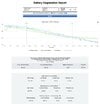I previously started a thread, How are LFP batteries holding up? about my experience with LFP batteries and felt it was time to give a short update. Also it is more relevant now that there are more LFP RWD 3's and Y's on the road.
My 55 kWh SR+ has now travelled 20,500 miles and average a 240 Wh/Mile over the past 2 years. When new, the car charged to 263-mile range and now charges to 251-mile range. That is a loss of 12 miles (or 4.56%) if I take the battery capacity it started with 53.97 kWh and is now at 51.46 kWh, as measured using the “consumption screen”. Where battery capacity in Wh = average Wh/mile x projected range ÷ SoC (best measured after charging to 100%). Example: 200 Wh/mile x 265 projected miles ÷ 100% SoC = 53,000 Wh or 53 kWh
So, my battery capacity has degraded by 51.46 ÷ 53.97 = 0.953 or 4.65% (or 2.33%/year). This result is also confirmed by TeslaFi’s Battery Degradation Report attached.

I guess that’s not too shabby, (and much better than my old SR+) but looking at the TeslaFi graph (blue line) my car continues to degrade at a constant rate, whereas others (green line) have started to level out! This might be because I have done less miles in the second year compared to the fleet average??
Looking in TeslaFi, Leaderboard, for highest Odometer readings for a 55 kWh LFP car, I found that user “Flinchy” has now done 132,000 miles, in a similar age car, and has only lost 4.88% of range. That result seems to suggest that LFP battery suffers more from calendar aging rather cyclical charging aging??
What are other LFP users finding?
Lastly, there was some concerns during the introduction of LFP batteries being able to cope when the temperature drops. Well, I have driven in temperature range from +39C and down to -7C and have had no real issues, apart from regen not being so strong in the low temperatures. However, maybe this is something that can be improved when Tesla bring in the function to automatically apply the brakes when regen is week… This may not be a bad effect as it does mean the brakes get some exercise in the winter that may stop them from seizing up!
My 55 kWh SR+ has now travelled 20,500 miles and average a 240 Wh/Mile over the past 2 years. When new, the car charged to 263-mile range and now charges to 251-mile range. That is a loss of 12 miles (or 4.56%) if I take the battery capacity it started with 53.97 kWh and is now at 51.46 kWh, as measured using the “consumption screen”. Where battery capacity in Wh = average Wh/mile x projected range ÷ SoC (best measured after charging to 100%). Example: 200 Wh/mile x 265 projected miles ÷ 100% SoC = 53,000 Wh or 53 kWh
So, my battery capacity has degraded by 51.46 ÷ 53.97 = 0.953 or 4.65% (or 2.33%/year). This result is also confirmed by TeslaFi’s Battery Degradation Report attached.

I guess that’s not too shabby, (and much better than my old SR+) but looking at the TeslaFi graph (blue line) my car continues to degrade at a constant rate, whereas others (green line) have started to level out! This might be because I have done less miles in the second year compared to the fleet average??
Looking in TeslaFi, Leaderboard, for highest Odometer readings for a 55 kWh LFP car, I found that user “Flinchy” has now done 132,000 miles, in a similar age car, and has only lost 4.88% of range. That result seems to suggest that LFP battery suffers more from calendar aging rather cyclical charging aging??
What are other LFP users finding?
Lastly, there was some concerns during the introduction of LFP batteries being able to cope when the temperature drops. Well, I have driven in temperature range from +39C and down to -7C and have had no real issues, apart from regen not being so strong in the low temperatures. However, maybe this is something that can be improved when Tesla bring in the function to automatically apply the brakes when regen is week… This may not be a bad effect as it does mean the brakes get some exercise in the winter that may stop them from seizing up!


